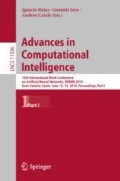Abstract
Sports and workout activities have become important parts of modern life. Nowadays, many people track characteristics about their sport activities with their mobile devices, which feature inertial measurement unit (IMU) sensors. In this paper we present a methodology to detect and recognize workout, as well as to count repetitions done in a recognized type of workout, from a single 3D accelerometer worn at the chest. We consider four different types of workout (pushups, situps, squats and jumping jacks). Our technical approach to workout type recognition and repetition counting is based on machine learning with a convolutional neural network. Our evaluation utilizes data of 10 subjects, which wear a Movesense sensors on their chest during their workout. We thereby find that workouts are recognized correctly on average 89.9% of the time, and the workout repetition counting yields an average detection accuracy of 97.9% over all types of workout.
Access this chapter
Tax calculation will be finalised at checkout
Purchases are for personal use only
References
Archerydirect.co.nz.: Human body figure (2019). http://www.archerydirect.co.nz/images/assetimages/human.png
Attal, F., Mohammed, S., Dedabrishvili, M., Chamroukhi, F., Oukhellou, L., Amirat, Y.: Physical human activity recognition using wearable sensors. MDPI Sens. 15, 31314–31338 (2015)
Bayat, A., Pomplun, M., Tran, D.A.: A study on human activity recognition using accelerometer data from smartphone. In: The 11th International Conference on Mobile Systems and Pervasive Computing, pp. 1–8 (2014)
Bergman, C., Oksanen, J.: Conflation of openstreetmap and mobile sports tracking data for automatic bicycle routing. Trans. GIS 20(6), 848–868 (2016)
Crema, C., Depari, A., Flammini, A., Sisinni, E., Haslwanter, T., Salzmann, S.: IMU-based solution for automatic detection and classification of exercises in the fitness scenario. In: 2017 IEEE Sensors Applications Symposium (SAS), pp. 1–6, March 2017. https://doi.org/10.1109/SAS.2017.7894068
Jahangiri, A., Rakha, H.A.: Applying machine learning techniques to transportation mode recognition using mobile phone sensor data. Strat. Manag. J. 16(5), 2406–2417 (2015)
Javed, T., Awan, M.A., Hussain, T.: Recognition of arm & elbow exercises using smartphone’s accelerometer. NFC-IEFR J. Eng. Sci. Res. 5, 1–6 (2017)
Liang, X., Wang, G.: A convolutional neural network for transportation mode detection based on smartphone platform. Strat. Manag. J. 18(7), 338–342 (2017)
Manzoni, V., et al.: Transportation mode identification and real-time CO2 emission estimation using smartphones. Technical report, Massachusetts Inst. Technol., Cambridge, MA, USA (2010)
Morris, D., Saponas, T.S., Guillory, A., Kelner, I.: RecoFit: using a wearable sensor to find, recognize, and count repetitive exercises. In: Proceedings of the SIGCHI Conference on Human Factors in Computing Systems, pp. 3225–3234. ACM (2014)
Movesense: Movesense sensor description (2019). https://www.movesense.com/product/movesense-sensor/
Patel, S., Park, H., Bonato, P., Chan, L., Rodgers, M.: A review of wearable sensors and systems with application in rehabilitation. JNER 9, 21 (2012)
Weka: Waikato environment for knowledge engineering. New Zealand Computer Science Research Students Conference, University of Waikato, Hamilton, New Zealand, pp. 57–64 (1995)
Author information
Authors and Affiliations
Corresponding author
Editor information
Editors and Affiliations
Rights and permissions
Copyright information
© 2019 Springer Nature Switzerland AG
About this paper
Cite this paper
Skawinski, K., Montraveta Roca, F., Findling, R.D., Sigg, S. (2019). Workout Type Recognition and Repetition Counting with CNNs from 3D Acceleration Sensed on the Chest. In: Rojas, I., Joya, G., Catala, A. (eds) Advances in Computational Intelligence. IWANN 2019. Lecture Notes in Computer Science(), vol 11506. Springer, Cham. https://doi.org/10.1007/978-3-030-20521-8_29
Download citation
DOI: https://doi.org/10.1007/978-3-030-20521-8_29
Published:
Publisher Name: Springer, Cham
Print ISBN: 978-3-030-20520-1
Online ISBN: 978-3-030-20521-8
eBook Packages: Computer ScienceComputer Science (R0)

